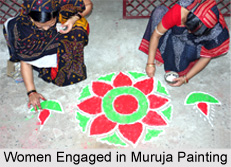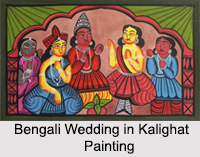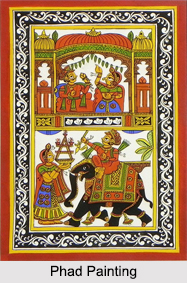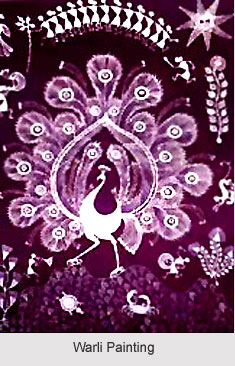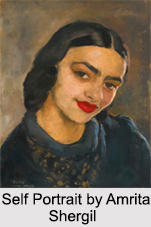 There are a significant number of painters in India who have made adequate contribution to the world of art and are known throughout the globe. Painting has a diverse history in the art and culture of India. The old dated cave paintings of the Ajanta and Ellora caves are evidence of the skill of an Indian artist. Beginning from the ancient times through the medieval times and the present modern days, painting has evolved from murals and miniatures to contemporary style with tinges of modern art, which is abstract as well as real.
There are a significant number of painters in India who have made adequate contribution to the world of art and are known throughout the globe. Painting has a diverse history in the art and culture of India. The old dated cave paintings of the Ajanta and Ellora caves are evidence of the skill of an Indian artist. Beginning from the ancient times through the medieval times and the present modern days, painting has evolved from murals and miniatures to contemporary style with tinges of modern art, which is abstract as well as real.
Early Indian Painters
The trajectory of Indian painting shows the remarkable evolution of artistic expression, transitioning from humble rock-cut creations within the depths of caves to the exquisite masterpieces adorning canvases and other materials. This evolution, spanning centuries, owes much to the pioneering contributions of early Indian painters who left an indelible mark on the world of art. These distinguished artists include Abanindranath Tagore, Amrita Shergil, Jamini Roy, Kalipada Ghoshal, Maniam, Manishi Dey, Mukul Chandra Dey, Nandalal Bose, Rabindranath Tagore, Raja Ravi Varma, S. G. Thakur Singh, Satyajit Ray, Silpi Benode Behari Mukherjee, Gaganendranath Tagore, and Sunil Das
These visionary artists, each with their distinct style and unique perspective, contributed significantly to the rich tapestry of Indian art. Their works continue to inspire and shape the artistic landscape, reflecting the diverse cultural heritage and vibrant history of India. From the traditional to the avant-garde, their legacy endures, serving as a source of inspiration for generations of artists to come.
Modern Indian Painters
The realm of modern Indian painters has breathed new life into the world of art, infusing it with fresh perspectives and innovative approaches. These contemporary artists have redefined the boundaries of artistic expression, creating a diverse tapestry of styles and genres. Among the notable modern Indian painters are Anish Kapoor, Abdul Kadar, Aditya Pande, Aman Singh Gulati, Anil Kumar Dutta, Anjolie Ela Menon, Amitabh Mitra, Chitra Ramanathan, Atul Dodiya,
Baiju Parthan, Balan Nambiar, Bharti Kher, and more.
These contemporary artists have not only pushed the boundaries of their craft but have also contributed significantly to the global art scene. Their work reflects the dynamism and diversity of contemporary Indian society and culture, offering fresh insights and perspectives for both art enthusiasts and connoisseurs worldwide.
Famous Indian Painters
Over the years, these painters of India have painted few pieces which have transcended time and culture to stake their rightful place in art history. Discussed and listed below are some of the most popular painters of India:
Abanindranath Tagore
Born on 7th August, 1871, Abanindranath Tagore is the nephew of the great Nobel laureate Rabindranath Tagore. He is regarded as the founder of the neo-Indian school of painting, known as the Bengal School and is one of the important painters of India. He was a major proponent of Swadeshi values in the tradition of art. That is the reason why he advocated for the Mughal and Rajput styles, which could stop the influx of western ideas of art. Abanindranath Tagore was also regarded as a renowned writer.
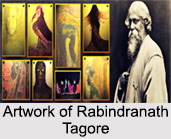 Rabindranath Tagore
Rabindranath Tagore
Rabindranath Tagore, one of India"s most celebrated renaissance figures and made India proud in 1913 by receiving the Nobel Prize for Literature is also a highly prolific artist. With no formal training in art, he transformed his lack of knowledge into an advantage and opened up new horizons as far as the use of lines and colours were concerned. The human face is a prominent constant in his artistic works and speaks of his undying interest in human persona. As a writer, Tagore linked human appearance with emotions and essence. He found a similar opportunity as a painter.
Raja Ravi Varma
A celebrated Indian Malayali painter and artist, Raja Ravi Varma is considered among the greatest painters in the history of Indian art for a number of aesthetic and broader social reasons. His works depict the examples of the fusion of European techniques and is also notable for making affordable lithographs availability of his paintings for the public. The works of Raja Ravi Varma are recognised by the depiction of scenes from the epics of Ramayana and the Mahabharata. He won the first prize in the Vienna Art Exhibition in 1873, and this brought him into the limelight.
Amrita Shergil
One of the prominent painters of India, Amrita Shergil is regarded to be a pioneer in modern Indian art. Born in 1913, Amrita Shergil was an avid traveller, deriving heavily from the art styles and cultures of the countries she visited. Her paintings mostly depicted the plight of women which made her art a beacon for women at large both in India and abroad. Shergil"s self-portraits are painted with an intensity that is almost hypnotic, drawing the viewer into the innermost psyche of the artist, where one discovers a sea of melancholy. Her art has influenced generations of painters of India from Sayed Haider Raza to Arpita Singh.
Nandalal Bose
Inspired by the works of the Tagore family and the murals of Ajanta, painter Nandalal Bose was one of the pupils of Abanindranath Tagore and is considered as one of the best modern painters of India. His subjects were basically themes from Indian mythology, villages and the women. He was the principal of the Kala Bhavan at Shantiniketan in the year 1922.
Dhiraj Choudhury
Born in 1936 then Bengal, now Bangladesh, painter Dhiraj Choudhury is known for his excellent artwork and is another name in the list of other important painters of India. Inspired by revolutionaries like Khudiram Bose, Aurobindo Ghosh, Rasbihari Bose and Subhash Chandra Bose, Dhiraj thought of a contemporary India, a mould where everyone will be equal. Thus in his works of art, one can see the narratives of the socio-political situations of modern India. Not only he has created wonderful pieces of art, he was once a professor of art in the Delhi College of Art, where he had also directed many projects on societal values and human race.
Jahar Dasgupta
A contemporary painter born in 1942, Jamshedpur, Jahar Dasgupta is a prominent figure among the painters of India. His paintings convey a message and are straight and firm in their execution. By using soft yet bright transparent colour, he is successful in sending the messages right across. He was trained initially in Shantiniketan under legendary artists like Ramkinkar Baiz and Benode Behari Mukherjee.
Jatin Das
Jatin Das, was born in Mayurbhanj in Odisha, and has some great artistic achievements into his account. His focus basically lies on man-woman relationships, in different phases of emotional turmoil, crisis, revelation and other moments. Human forms, mostly painted in nudes, sometimes birds and animals constitute his subject of study. Jatin Das with his artistry and creativity is therefore indeed one of the eminent painters of India.
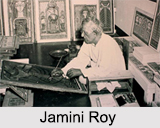 Jamini Roy
Jamini Roy
One of the renowned painters of India, Jamini Roy"s works portrays the prevalence of the Kalighat paintings and the village Patuas. In 1955, Jamini Roy was honoured with the Padma Bhushan for his works of art. Initially, his paintings expressed a touch of the Western and modern style but in the later years, he was inspired by the Bengali Folk Traditions which he incorporated in his works.
M.F. Hussain
Associated with Indian modernism in the 1940s, M.F.Hussain was a painter of international acclaim, and a founding member of the Bombay Progressive Artists" Group. Among all the other famous painters of India, M.F. Hussain has been called the "Picasso of India" and was the most prolific painter of the 21st century. He enjoyed depicting the lively and free spirit of horses in many of his works. His other themes includes topics as diverse as Mahatma Gandhi, Mother Teresa, scenes from the epics Ramayana and Mahabharata and the British Raj, he also painted motifs of Indian urban and rural life.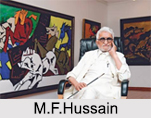
Satish Gujral
He was born in Jhelum in 1925, and recognised as one of the renowned contemporary artists, as well as sculptor, architect and writer and one of the great painters of India. Satish Gujral has experimented with plastic art, sculpture murals and also graphics. He has won the National Award three times, and exhibited his works in India and abroad and was also awarded the Padma Vibhushan in 1999.
Sayed Haider Raza
One of the most distinguished painters of India; the works of S.H. Raza are mainly abstracts in oil or acrylic, with a very rich use of colour, replete with icons from Indian cosmology as well as its philosophy. He popularised the Indian iconography globally and made the "bindu" or "shunya" the focal point of energy in his work.
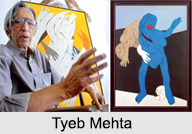 Tyeb Mehta
Tyeb Mehta
One of the internationally recognized painters of India, Tyeb Mehta is a multitalented individual. Initially, he started his career as a film editor but later his interest shifted towards painting which led him to the J.J. School of Art. He is known for his paintings of figures set amidst diagonal shapes of colour. The artist"s combination of abstracted and expressionistic elements was influenced by the work of both Francis Bacon and Barnett Newman.
V. S. Gaitonde
Vasudeo S. Gaitonde, often celebrated as the painter of silence, stands as a seminal figure in the annals of Indian modern art. Amidst the backdrop of renowned Indian painters and their notable works, Gaitonde remains a somewhat lesser-known luminary. Born in Nagpur, Maharashtra, in 1924, Vasudeo S. Gaitonde`s indelible mark on Indian art is characterized by his enigmatic and abstract creations. Gaitonde`s artistic journey began with his education at the esteemed J.J. School of Art in Bombay (now Mumbai). His remarkable talents soon led him to become one of the founding members of the Progressive Artists` Group of India, a pivotal collective in the Indian art scene. His dedication to art was matched only by his adherence to Zen Buddhism, a spiritual path that profoundly influenced his perspective.
Ram Kumar
Ram Kumar, an artist bestowed with the prestigious Padmashree and Padma Bhushan awards, embarked on an intriguing journey through destiny`s labyrinth. His multifaceted life led him from banking and writing to becoming a foremost abstract artist characterized by profound philosophical contemplation. Born in Shimla, Himachal Pradesh, in 1924, Ram Kumar chanced upon an art exhibition near Connaught Place, a pivotal encounter that would forever alter the course of his life. Drawn irresistibly to the world of art, he became a frequent visitor to such exhibitions.
He enrolled in classes at the Sharda Ukil School of Art. Fate intervened when he crossed paths with S.H. Raza at an art exhibition, leading to a lasting friendship. Raza played a pivotal role in persuading Ram`s father to send him to Paris, where he would study under the tutelage of renowned artists Andre Lohte and Fernand Leger. In 1952, Ram Kumar returned to his homeland, India. An astute observer, he witnessed the nation`s post-independence era, characterized by its gradual emergence as a self-reliant entity. His paintings conveyed the desolation of youth with solemn expressions and somber eyes, reflecting the emotions of the common man of the time.
The allure of Ram Kumar`s work lay not only in its poignant portrayal but also in the mastery with which he positioned his subjects within the compositions. His paintings vividly depicted poorly constructed houses, winding streets, and dangling cables, symbolizing the struggles of ordinary people. He also ventured to Varanasi, capturing the city`s essence with exquisite artistic finesse.
Francis Newton Souza
Francis Newton Souza, born in Saligao, Goa, in 1924 hailed from a Roman Catholic family and played a pivotal role as a co-founder of the Bombay Progressive Artists` Group. He played an instrumental role in bringing together renowned artists such as Raza, Husain, Bakre, Mehta, Ram Kumar, Krishen Khanna, KH Ara, and Akbar Padamsee to form the celebrated Bombay Progressive Artists` Group.His artistic philosophy was characterized by a profound belief that an artist`s responsibility extends beyond capturing the serene beauty and aesthetic qualities of the world. It also encompasses portraying the harsh realities and societal grotesqueries that persist.
In 1947, Souza founded the Bombay Progressive Artists` Group with the aim of providing a platform for Indian artists to showcase their talents on the global stage. He became the first Indian artist after independence to have his work featured in Western exhibitions, with a notable display at London`s Burlington House in 1948. Subsequently, in 1949, Souza made London his new home. In 1954, Souza`s work was exhibited at The Institute of Contemporary Arts, marking a significant milestone.

